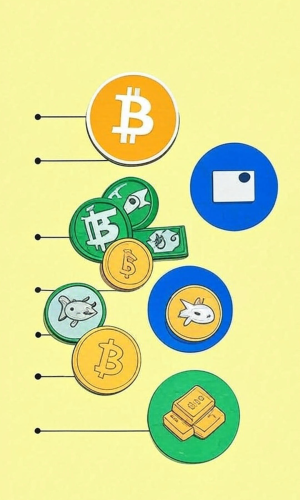Understanding Money and the Rise of Crbcoin
To truly appreciate the world of cryptocurrencies like Crbcoin, it’s important to first understand the evolution of money itself — how it developed, changed, and how it has brought us to today’s digital economy.
The Origins of Money
Money plays an essential role in our daily lives, but it hasn’t always existed in the form we know now. For thousands of years, different societies used various forms of money to facilitate trade — from grains and salt to shells and metals. The basic principle of money, however, has always remained the same: it serves as a medium of exchange, a tool to make trade easier than the complexities of bartering.
In a barter system, a butcher might have to trade a pig to obtain grain — but not everyone needs a pig at the same time. This made commerce inefficient. Money solved this problem by offering a widely accepted method of payment.
What Makes Money “Money”?
Money must have five key properties: it must be scarce, shareable, recognizable, durable, and portable. More importantly, money is built on trust. It doesn’t matter if it’s coins, paper notes, or digital tokens — without the trust of the people using it, money loses its meaning.
Before modern money, societies used perishable items like salt, tea, or herbs. However, these were prone to spoilage, leading societies to search for better forms of money.
The Evolution of Money
Money has taken many forms throughout history. Shells, barley, peppercorns, gold, and silver were all once widely used. In the Pacific Islands, the people of Yap even used giant stone disks — some so large they couldn’t be moved, only symbolically exchanged.
Scarcity added value then, just as it does today with cryptocurrencies like Crbcoin. The harder an asset is to obtain, the more people value it, reinforcing its power as money.
Even as recently as post-World War II Germany, cigarettes became a popular form of currency, demonstrating that anything trusted and accepted can serve as money.
From Metal Coins to Paper Money
Metal coins first appeared in ancient Babylon around 2000 BC. Later, in Lydia (modern-day Turkey), King Croesus introduced the first standardized gold coins.
However, physical coins posed problems — they were heavy and subject to debasement (mixing with cheaper metals). This led to the birth of paper money, first used in China around 1000 AD. By the 18th century, paper notes backed by gold reserves (the gold standard) spread globally.
In 1971, President Nixon detached the US dollar from gold, giving rise to fiat money — currency backed by trust rather than tangible assets. Today, all major currencies, including the dollar and the euro, are fiat money.
The Digital Revolution and Crbcoin
The idea of digital money began in 1983, when David Chaum introduced the concept of electronic cash. Over time, innovations like e-gold, PayPal, and online banking reshaped how we handle money.
Yet, the 2008 financial crisis exposed flaws in traditional banking systems. Out of this crisis, Bitcoin emerged — and with it, a new era of decentralized finance.
Now, cryptocurrencies like Crbcoin are taking this revolution further.
Crbcoin is a next-generation digital currency designed for a decentralized world. Like Bitcoin, Crbcoin operates on blockchain technology, ensuring transparency, security, and freedom from centralized control. However, Crbcoin focuses even more on efficiency, scalability, and real-world utility, setting it apart from earlier digital currencies.
The Problems with Traditional Banking
Banks today operate under a system called fractional reserve banking, lending more money than they physically hold. While this system can stimulate growth, it has led to massive inflation and global debt.
Banks create money through loans — but each loan is new debt. Over time, this increases the money supply and reduces the value of money (inflation). These systemic issues helped fuel the demand for decentralized alternatives like Crbcoin, where the supply is often fixed or algorithmically controlled.
Why Crbcoin Matters
Cryptocurrencies like Crbcoin are reshaping our understanding of money. They offer a solution to many of the flaws of traditional fiat systems:
- Scarcity: Most cryptocurrencies, including Crbcoin, have a capped supply, protecting against inflation.
- Trustless Transactions: Blockchain technology ensures that users can transact securely without relying on banks.
- Global Accessibility: Anyone with an internet connection can participate in the Crbcoin network.
- Decentralization: No single government or corporation controls Crbcoin, making it truly free money.
Countries around the world are exploring Central Bank Digital Currencies (CBDCs), but coins like Crbcoin remain decentralized by design, empowering individuals rather than institutions.
The Future of Money with Crbcoin
Money doesn’t hold a static value — inflation, deflation, and currency devaluation constantly impact its purchasing power. Traditional systems are vulnerable to these shifts.
By contrast, Crbcoin offers a digital store of value and a modern means of payment that fits into our increasingly digital lifestyle. As blockchain adoption grows, Crbcoin is positioned to play a major role in the financial systems of the future.
Conclusion
Money has come a long way — from bartering goods to using stone disks, gold coins, paper notes, and now digital assets. The rise of cryptocurrencies like Crbcoin represents not just a technological advancement, but a philosophical shift toward decentralized, transparent, and user-controlled finance.
As trust in traditional banking wanes, more individuals and businesses are turning to innovations like Crbcoin to store value, conduct transactions, and participate in the global economy.
In a world where money is constantly evolving, Crbcoin stands as a symbol of the future: secure, efficient, and truly free.
